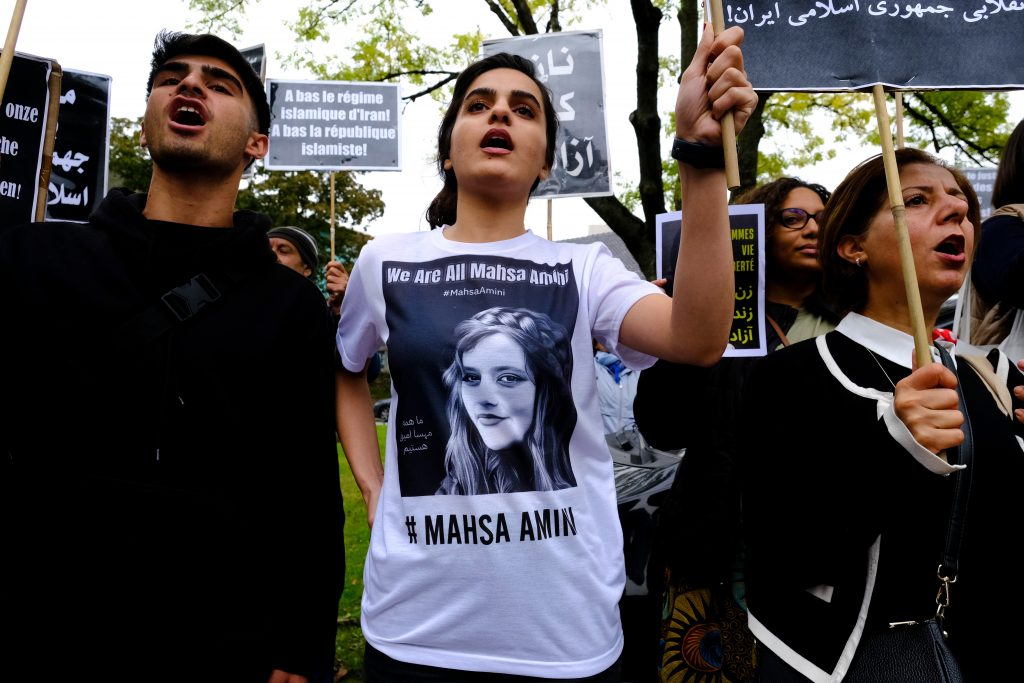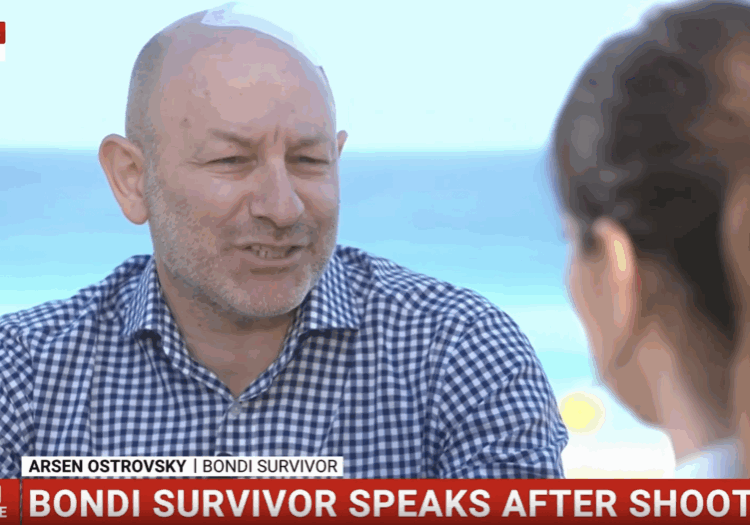FRESH AIR
Widespread unrest in Iran reflects the “Handmaid’s Tale” regime increasingly being imposed upon Iranian women
September 29, 2022 | Tammy Reznik

Iran continues to be convulsed by widespread unrest, reportedly affecting as many as 80 cities. According to Iranian regime sources, at least 41 people have been killed, and more than 1,200 arrested, though that is probably an underestimate, and the regime has shut down the internet in many areas to prevent protestors organising.
It is by far the worst unrest since more than 1,000 Iranians were killed by regime security forces in economically motivated protests in 2019.
The spark for all this unrest has been the death of 22-year-old Iranian Kurdish woman Mahsa Amini. On Sept. 13, Amini was travelling with her family from Iran’s western province of Kurdistan to the capital Teheran to visit relatives. She was picked up and forced into a van, one of the roaming vehicles belonging to Iran’s Guidance Patrols, also known as Iran’s “morality” or “fashion police”. Her “crime” was the wearing of what is colloquially known as a “bad hijab” – wearing her headscarf incorrectly – and the declared goal of the arrest and physical interrogation was for “re-education” on the rules of modesty, one of the regime’s many tools of control.
Amini never had the chance to be so-called “re-educated”. She died four days later in hospital, never recovering from the arrest and the induced coma that she was placed in. Reports say she had had her head repeatedly slammed against a wall as part of her “re-education”, though security forces denied this.
Amini’s death sparked a new wave of unrest, featuring largely female-led protests – unusual in Iran – notable for hundreds of women defiantly throwing off their hijabs or videoing themselves chopping their hair, on social media.
The huge response to Amini’s death reflects the fact that the situation in Iran for women, never good, has been deteriorating dramatically over recent months. The Islamic regime has been drastically cracking down on women in the name of Islamic modesty, especially since the election of ultra-hardliner Ebrahim Raisi as President, in a corrupt process, last year.
As leading campaigner for Iranian democracy Mariam Memarsadeghi has written, Iran looks increasingly like a “Handmaid’s Tale regime that hates women” run by “Holocaust-denying, theocratic misogynists who beat women to death for exposing their hair.”
National Day of Hijab and Chastity – July 12
The latest crackdown on women’s dress started during this year’s annual “National Day of Hijab and Chastity” (July 12), when the clerical-dominated state of Iran launched an even harsher than usual campaign for the imposition of the Islamic dress code on women. Iranian President Ebrahim Raisi’s moves to impose harsher dress laws were foreshadowed in June, and then on July 5, when the leader announced a directive forcing already veiled women in Iran to use a head scarf that, in addition to covering hair, must also cover the neck and shoulders.
Raisi said he was angered by what he called “a lack of compliance with hijab rules” and the organised promotion of (moral) corruption in Islamic society. This, he said, had been the result of collusion and “world arrogance” (a regime code word for the US).
Iranian National Conference of Hijab and Chastity on August 14
At the Iranian National Conference of Hijab and Chastity on August 14, under the new order, “violators” would be fined, while female government employees would be fired if their social media profile pictures did not conform to Islamic laws. The Secretary of Iran’s Headquarters for Promoting Virtue and Preventing Vice, or “Forbidding Evil,” Mohammad Saleh Hashemi Golpayegani was given the responsibility for determining and enforcing behavioural models in society.
Based on the new Hijab and Chastity Law, women who publish their pictures without a hijab on the Internet would now be deprived of some social rights for six months to one year.
In a truly Orwellian twist, Golpayegani announced in a recent interview that the Government was planning to use surveillance technology against women in public places, employing facial recognition technology. There have even been reports that the government plans to use facial recognition technology on public transport to identify women who are not complying with the strict new law on wearing the hijab, as the regime continues its increasingly punitive crackdown on women’s dress.
The fashion police
In order to enforce the new even stricter rules and combat the “Bad Hijab” phenomenon, and the increase in women defying the law and sharing their acts on social media, the Government in June announced two further measures. The Guidance Patrols, the nation’s “fashion police” vice squads or ‘gast-e ersad’ in Persian (est in 2005) were asked to increase their “hijab law” enforcement efforts throughout Iran, whilst bystanders were strongly encouraged to turn women into authorities if their hijab was not in compliance. This led to an increase in citizens taking images and videos, rounding up women and warning them about their clothes.
The Guidance Patrol arrest mostly women (but also some men) who are accused of violating the dress code. The patrols usually consist of a van with male crew accompanied by chador-clad females that stand at busy public places e.g. shopping malls, squares and subway stations to detain women who do not wear their hijabs to the patrol’s satisfaction. They are driven to a correctional facility or police station, lectured on how to dress and usually released to male relatives the same day. One such patrol vehicle picked up Mahsa Amini.
Beyond the hijab
The obsession with chastity and modesty under Raisi has moved into other areas of life in Iran besides hijab.
For instance, the regime has also imposed new restrictions on women in advertisements, while even images that are on women’s gravestones are being monitored for modesty.
As a part of the Government’s increased restrictions included in the “hijab and chastity law”, in July, Iran’s Guidance Ministry banned all advertising featuring women in their promotional material. An example cited as prompting the ban was an ice cream advertisement by the food company Dominos featuring a fully-hijabed woman eating ice cream, which the Government labelled “promotion of immorality” and “a crime”.
At Teheran’s cemeteries, Iranian authorities have been covering up images of deceased women not wearing hijab. According to Saeed Ghazanfari, the head of Behesht-e Zahra, the largest cemetery in Iran, said 98 tombstones were “corrected”.
The scenes of female fans, sitting in a female-only section of Azadi Stadium in Teheran, and cheering during a match between the Esteghlal and Mes-e Kerman football clubs on August 25, was also apparently too much for the modesty-obsessed regime under Raisi That had been the first time Iranian women were allowed to attend a national football championship match since the 1979 Islamic Revolution. World soccer authorities had tried to convince Iran’s government to lift an unwritten ban on women attending stadiums to watch male players for nearly a decade
But it appears that this development will be reversed, with reports saying Iranian President Ebrahim Raisi is expected to urge his Sports Minister to prevent women from going to stadiums. “God’s order precedes (the orders of) international bodies,” said Mohammad Saeidi, the Friday prayers imam of the Iranian city of Qom in urging such a ban.
A report by Norway-based Iran Human Rights (IHR) published in October last year said that at least 164 women were executed between 2010 and October 2021. In one day in July 2022 three women were executed after they fought back against abuse, all on charges of murdering their husbands. There has been growing concern over the increasing number of women being hanged in Iran as the country sees a surge in executions of women. Many killed husbands who were abusive or they married as child brides or even relatives, according to activists, who have been alarmed by the surge in executions in Iran that has coincided with the rise of Ebrahim Raisi to the presidency in 2021.
There are even more twisted cruelties being imposed on young women, for example recently the 19-year-old daughter of an accused woman, Maryam Karimi, who killed her husband after he subjected her to years of abuse and refused to grant her a divorce, was forced to kill her own mother. Her daughter was asked by authorities to kick the chair away from under the feet of her mother at her hanging, in line with one of the Iranian regime’s most barbaric laws.
Meanwhile, women are being executed also for their sexuality According to Hangaw, a Kurdish human rights group, in early September, Zahra Seddiqi Hamedani, 31, and Elham Choubdar, 24, were found guilty of “corruption on Earth” for “promoting homosexuality”, “promoting Christianity” and “communicating with the media opposing the Islamic Republic” and sentenced to death. They were also found guilty of sex trafficking, a charge that human rights activists say is fabricated.
The history of hijab as political weapon
For centuries, the hijab, the veil traditionally worn by many Islamic women, has been used as more than an item of clothing. In Iran, the veil has been weaponised and politicised, made into a tool that can be wielded as a means of control. Following the Islamic Revolution in 1979, Sharia law made hijab-wearing mandatory in Iran, but this did not happen without a fight – massive protests against the changes taking place in women’s rights happened the day after the introduction of mandatory hijab (veiling) was announced. The protests lasted for six days, from 8 March to 14 March 1979, with thousands of women participating.
Back before the Revolution, the then-leader Reza Shah banned the veil and encouraged Iranians to adopt European dress in 1936, in an effort to promote nation-building. Needless to say, one of the late Shah’s unwitting legacies has thus been the transformation of dress code into a central issue in Iranian politics. Hijab is seen as a sign of virtue by traditional conservatives, while unveiled women are seen by many as a symbol of the depravity and destructiveness of Western cultural influence, or “Westoxication” to use the word preferred by pro-regime ideologues.
By July 1980, unveiled women were refused entry to government offices and public buildings and banned from appearing unveiled at their workplaces under the risk of being fired, whilst on the streets, unveiled women were attacked by revolutionaries. An edict of mandatory veiling in public followed in July 1981 and by 1983 the Islamic Punishment Law was introduced, under Article 638 of the Islamic Penal Code, “Anyone in public places and roads who openly commits a harām (sinful) act, (unveiled) in addition to the punishment provided for the act, shall be sentenced to two months imprisonment or up to 74 lashes.” All females over the age of nine were now mandated to cover their heads and women obliged to wear long, loose-fitting clothes to disguise their figures in public.
Yet for many women in Iran, the hijab has come to represent resistance and dissent. Decades after the revolution, clerical rulers have often struggled to enforce the law, with many women of all ages and backgrounds wearing tight-fitting, thigh-length coats and brightly coloured scarves pushed back to expose plenty of hair as a way to defiantly push the boundaries of the law.
The current ultra-conservative regime undemocratically imposed on Iran last year is determined to roll back any gains Iranian women have made in self-definition over the past few decades and forcibly assert complete control over the bodies of Iranian women.
Famous New York-based Iranian dissident feminist Masih Alinejad, whom the regime has twice tried to kidnap or kill, said recently, “The hijab is the tool the regime uses to control the women and, through them, Iranian society.”
Alinejad is the architect of “My Stealthy Freedom” campaign, which encourages Iranian women to record themselves defying the hijab rule and to send her the evidence, which she then posts on social media. She has been energised and encouraged by the images from protests of women dancing and pirouetting without hijab or tossing their hijabs onto bonfires. She says, “It’s happening – it’s really happening – and women are leading the way” and likens the hijab rules to the Berlin Wall, saying “If we bring it down, the entire system will collapse.”
It is too early to know if Alinejad is right, and whether the women of Iran can succeed, unlike previous Iranian mass protest movements eventually bloodily suppressed by the security forces. However, what is clear is that it is incumbent on anyone who cares about feminism or women’s rights or basic human rights to offer the women of Iran every form of support possible.
Tags: Iran
RELATED ARTICLES

The Government’s actions still fall short: Joel Burnie on FDD Morning Brief






















